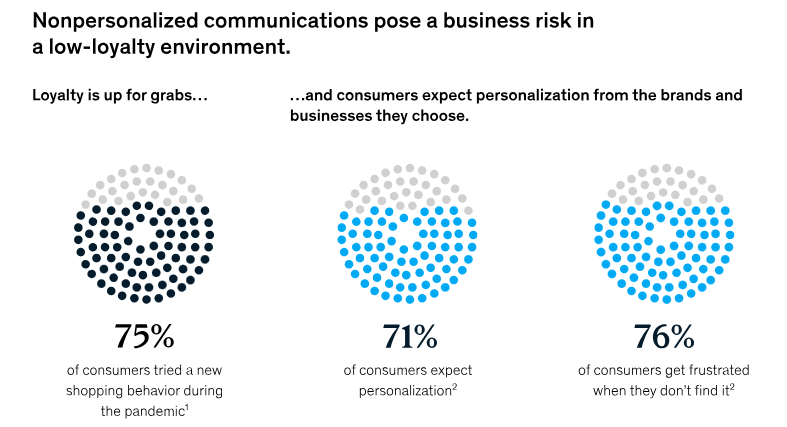
Personalization vs Privacy: Walking the Fine Line in Omnichannel Campaigns
We’ve all been there—you Google hiking boots once, and suddenly your Instagram, YouTube, and inboxes are flooded with trail-ready footwear ads. Creepy or convenient? That depends on where you land in the “personalization vs. privacy” debate.
In today’s omnichannel marketing landscape, brands are walking a tightrope. On one side, consumers expect personalized experiences. On the other, they’re growing more cautious about how much data they’re handing over.
So, how do marketers deliver tailored content without crossing the line? And are the tools we use helping or hurting our privacy efforts? Here’s a crash course in the fine art of being useful without being intrusive.
How to personalize without giving up on privacy
Before diving into examples, let’s get one thing straight: personalization isn’t the enemy of privacy—it’s just often misunderstood. The real power lies in creating value without crossing the line. Smart brands know that trust is the new currency, and ethical data use is non-negotiable.
We’re living in the golden age of customization. From Spotify playlists that match your mood to product recommendations you were just about to search for, customers love a personalized digital experience. According to McKinsey & Company, 71% of consumers expect companies to deliver personalized interactions—and 76% become frustrated when they don’t.
It’s no surprise, then, that personalization makes customers feel more seen, appreciated, and loyal. And it pays off: brands that get personalization right generate 40% more revenue than their peers. The message is clear—customers aren’t just enjoying personalization; they’re demanding it.

But here’s the catch—people also care (a lot) about their privacy. It’s the unspoken deal in the digital world: customers are willing to share their data, but only if they feel confident that brands will use it responsibly. The irony? We crave those personalized experiences but flinch at the thought of being tracked.
That’s why personalization vs privacy isn’t a tug-of-war—it’s a balancing act built on trust, transparency, and delivering value at just the right moment.
The omnichannel challenge: One customer, many touchpoints
Omnichannel isn’t just a buzzword—it’s reality. With endless distractions and options, consumers jump from device to device, platform to platform, expecting a seamless experience.
If they browse a product on their laptop, they want a gentle nudge on their phone, not a full-blown sales pitch. They want their cart remembered, their preferences saved, and their interactions to feel like a continuous conversation, not a game of telephone. To deliver that kind of experience, marketers need data—behavioral, demographic, transactional, even psychographic.
The challenge? Using that data ethically. With rising privacy concerns and stricter regulations like GDPR and CCPA, consumers now expect transparency, consent, and control. Ethical use means being clear about what’s collected, why it’s needed, and ensuring personalization never crosses into creepiness.
In omnichannel marketing, trust is everything—and without it, even the smartest data strategy can backfire.
When personalization feels more like a surveillance
In today’s digital world, where brands live across websites, apps, social media, and even physical stores, personalization is everywhere. But when it’s overdone or poorly explained, it starts to feel less like service—and more like surveillance.
Personalization and privacy aren’t enemies—they’re dance partners. The goal isn’t choosing one over the other, but designing with your customer, not just for them. That means asking before acting, explaining before collecting, and offering real value before trying to sell.
Consumers are willing to share—but only when trust is earned. Smart brands know this isn’t a data grab; it’s a relationship. When done right, personalization feels like a thoughtful exchange, not a digital ambush. It’s the difference between “Wow, they get me” and “Yikes, how did they know that?”
The brands that win lead with permission, not assumption. They strike the right balance between relevance and respect—staying human in an increasingly automated world.
Today’s consumers are savvy and selective. They want answers: Why do you need this data? How will you use it? Can I opt out? Brands that answer clearly and respectfully earn loyalty. The rest? They risk becoming cautionary tales on Reddit threads and social feeds.
The consent revolution around zero-party data
The good news? You don’t need to spy to personalize. Enter zero-party data—information customers willingly share. Think style quizzes, preference centers, account settings, and feedback forms. It’s a data goldmine with consent built in.
Unlike third-party data—now fading fast thanks to cookie crackdowns and tighter regulations—zero-party data is clean, ethical, and powerful. You know where it came from, what it means, and best of all, users stay in control. That control is central to the personalization vs. privacy conversation.
Take Ulta Beauty, for example. In 2025, the brand boosted customer engagement through AI-driven personalization powered by zero-party data. By capturing preferences directly from users, Ulta delivered tailored recommendations and messaging that deepened trust and loyalty.
The takeaway? When brands give consumers clear choices and let them share what matters, personalization becomes a service—not a surveillance tactic. It’s not about how much you know, but how you use it to empower your audience.
In a privacy-conscious world, vague data practices won’t fly. Gen Z and Millennials especially expect brands to be transparent—making privacy a core part of the user experience. That means no more fine print. Instead: clear opt-ins, interactive settings, and plain-language explanations for what’s collected and why.
However, ethical marketing doesn’t end with transparency; it extends to how personalization is executed. Think Netflix’s behavior-based recommendations or Starbucks’ location-aware offers based on past orders. Smart brands personalize with context, not just identity—creating experiences that feel intuitive, not invasive. When transparency meets thoughtful personalization, trust naturally follows.
Cut to the chase
Personalization drives results —but when it crosses into privacy invasion, trust is broken. Giving consumers authority over information, upholding clear data policies, and creating experiences that put people before clicks are crucial for omnichannel campaigns. This not only gains trust but creates a meaningful connection between the brand and customers that feels personal, not invasive.


